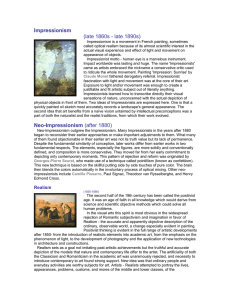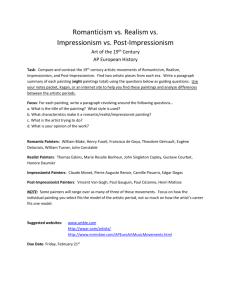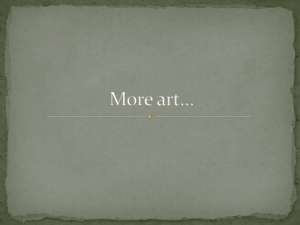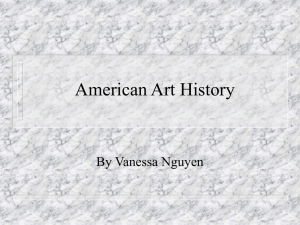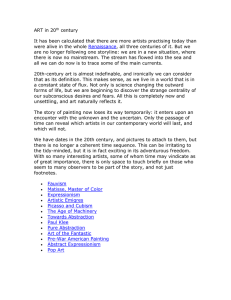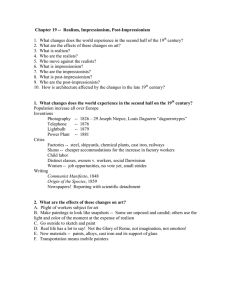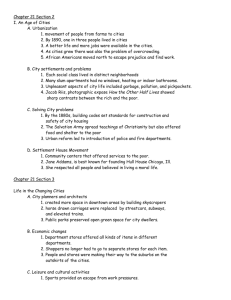Realism (1850-1880)
advertisement
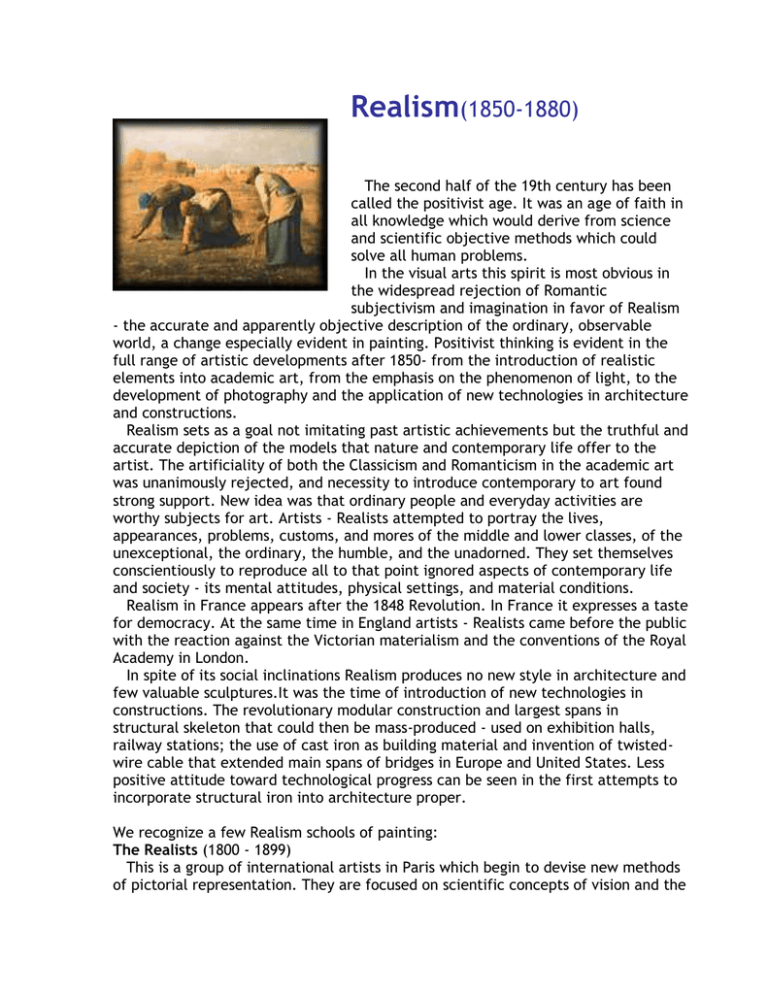
Realism(1850-1880) The second half of the 19th century has been called the positivist age. It was an age of faith in all knowledge which would derive from science and scientific objective methods which could solve all human problems. In the visual arts this spirit is most obvious in the widespread rejection of Romantic subjectivism and imagination in favor of Realism - the accurate and apparently objective description of the ordinary, observable world, a change especially evident in painting. Positivist thinking is evident in the full range of artistic developments after 1850- from the introduction of realistic elements into academic art, from the emphasis on the phenomenon of light, to the development of photography and the application of new technologies in architecture and constructions. Realism sets as a goal not imitating past artistic achievements but the truthful and accurate depiction of the models that nature and contemporary life offer to the artist. The artificiality of both the Classicism and Romanticism in the academic art was unanimously rejected, and necessity to introduce contemporary to art found strong support. New idea was that ordinary people and everyday activities are worthy subjects for art. Artists - Realists attempted to portray the lives, appearances, problems, customs, and mores of the middle and lower classes, of the unexceptional, the ordinary, the humble, and the unadorned. They set themselves conscientiously to reproduce all to that point ignored aspects of contemporary life and society - its mental attitudes, physical settings, and material conditions. Realism in France appears after the 1848 Revolution. In France it expresses a taste for democracy. At the same time in England artists - Realists came before the public with the reaction against the Victorian materialism and the conventions of the Royal Academy in London. In spite of its social inclinations Realism produces no new style in architecture and few valuable sculptures.It was the time of introduction of new technologies in constructions. The revolutionary modular construction and largest spans in structural skeleton that could then be mass-produced - used on exhibition halls, railway stations; the use of cast iron as building material and invention of twistedwire cable that extended main spans of bridges in Europe and United States. Less positive attitude toward technological progress can be seen in the first attempts to incorporate structural iron into architecture proper. We recognize a few Realism schools of painting: The Realists (1800 - 1899) This is a group of international artists in Paris which begin to devise new methods of pictorial representation. They are focused on scientific concepts of vision and the study of optical effects of light. The Realists express both a taste for democracy and rejection of the inherent old artistic tradition. The Realists felt that painters should work from the life round them. Indisputable honest, the Realists desecrated rules of artistic propriety with their new realistic portrayals of modern life. Artists: Marie Rosalie Bonheur, John Singleton Copley, Gustave Courbet, Honoré Daumier, Hilaire Germain Edgar Degas, Thomas Eakins, Ignace Henri Theodore FantinLatour, Wilhelm Leibl, Edouard Manet. Barbizon School (1840s - 1850s) Barbizon School was a group of French landscape artists one of first formed outside the Academy. They were named after the Forest of Fonteblau near the village of Barbizon where they got away from the revolutionary Paris to produce their art. They attempted to paint nature directly; Constable who pioneered in making landscape painting a faithful depiction of nature was their model. The Barbizon painters helped establish landscape and motif of country life as vital subjects for French artists. They also cherished an interest in visible reality, which became increasingly important to the later artistic styles. Artists in the group: Camille Corot, Charles-François Daubigny, Jean-François Millet, Pierre-EtienneThéodore Rousseau. The Pre-Raphaelite Brotherhood (1848 - late 19th Century) In 1848 a group of English painters, poets and critics formed the Pre-Raphaelite Brotherhood to reform art by rejecting practices of contemporary academic British Art. They have been considered the first avant-garde movement in art. They accepted the doctrine of imitation of nature, as central purpose of art. Instead of the Raphaelesque conventions taught at the Royal Academy, their central doctrine was that artists should seek to represent the natural world. They believed that the only great art was before high renaissance, before Raphael. He was representative of the time when painters would scarify the reality of the subject to their own ideals of beauty and morality. The Pre-Raphaelite Brothers condemned this art of idealization, and promoted works based on real landscapes and models, and paid intense attention to accuracy of detail and color. They advocated as well a moral approach to art, in keeping with a long British tradition established by Hogarth. The combination of didacticism and realism characterized the first phase of the movement. The landscape compositions were painted outdoors, what was an innovative approach at the time. The interest in the Middle Ages inaugurated the second, unofficial phase of PreRaphaelitism. Their subject matters were from medieval tales, bible stories, classical mythology, and nature. With technique of bright colors on a white background, they achieved great depth and brilliance. However, we can see now the curve from their immature rebelliousness, through the realistic painting of detail without idealization, to works of art that are finally more surreal than real. Their work cannot be realistic with the mythological matter and medieval tales that they chose - they can only be envisioned in the mind and do not exist outside of there. So they ended up closer to some other art rebellions - -Symbolists. Impressionism (late 1860s - late 1890s) Impressionism is a movement in French painting, sometimes called optical realism because of its almost scientific interest in the actual visual experience and effect of light and movement on appearance of objects. Impressionist motto - human eye is a marvelous instrument. Impact worldwide was lasting and huge. The name 'Impressionists' came as artists embraced the nickname a conservative critic used to ridicule the whole movement. Painting 'Impression: Sunrise' by Claude Monet fathered derogatory referral. Impressionist fascination with light and movement was at the core of their art. Exposure to light and/or movement was enough to create a justifiable and fit artistic subject out of literally anything. Impressionists learned how to transcribe directly their visual sensations of nature, unconcerned with the actual depiction of physical objects in front of them. Two ideas of Impressionists are expressed here. One is that a quickly painted oil sketch most accurately records a landscape's general appearance. The second idea that art benefits from a naïve vision untainted by intellectual preconceptions was a part of both the naturalist and the realist traditions, from which their work evolved. Neo-Impressionism (after 1880) Neo-Impressionism outgrew the Impressionism. Many Impressionists in the years after 1880 began to reconsider their earlier approaches or make important adjustments to them. What many of them found objectionable in their earlier art was not its truth value but its lack of permanence. Despite the fundamental similarity of conception, later works differ from earlier works in two fundamental respects. The elements, especially the figures, are more solidly and conventionally defined, and composition is more conservative. They moved far from her early commitment to depicting only contemporary moments. This pattern of rejection and reform was originated by Georges-Pierre Seurat, who made use of a technique called pointillism (known as confettiism). This new technique is based on the skillful putting side by side touches of pure color. The brain then blends the colors automatically in the involuntary process of optical mixing. Other neo-impressionists include Camille Pissarro, Paul Signac, Theodoor van Rysselberghe, and Henry Edmond Cross. Karya Camille Pisaarro
